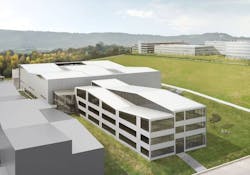TRUMPF invests nearly $80M in EUV laser facility in Ditzingen
For more than 70 million euros (nearly $80 million dollars), TRUMPF says it is going to build a new home for its extreme ultraviolet (EUV) technology. To create optimal conditions for this high-tech EUV microchip production method, new buildings covering an overall area of almost 34,000 square meters are due for construction at the TRUMPF headquarters in Ditzingen, Germany over the next two years. A multi-story hall will include not only production areas and clean rooms but also zones for testing and start-up. Space for 270 jobs is planned for an adjacent office block.
RELATED ARTICLE: EUV lithography has yet to find its way into the fab
"We're developing and producing unique and highly complex laser systems here, and this is creating high-tech jobs in Germany," said TRUMPF president Nicola Leibinger-Kammüller. The project is being planned by the architectural practice Barkow Leibinger, and the investment sum includes the costs of construction as well as setup of the elaborate building automation required by EUV technology.
The new buildings will be used primarily by company's subsidiary TRUMPF Lasersystems for Semiconductor Manufacturing. Founded in late 2014, it exclusively handles production and further development of TRUMPF laser amplifiers and related components. For these amplification systems, four high-power lasers are connected in series in order to generate extremely powerful laser pulses. These pulses then hit tin droplets inside a vacuum, generating very short-wavelength EUV light. As part of a special exposure process, this enables the creation of tiny structures on microchips; less than 10 nm in size, they are even smaller than a flu virus. This means that in the future, over ten billion transistors will fit on to just one single microchip--making smartphones and other optoelectronic devices far more powerful than they are today.
SOURCE: TRUMPF; http://www.trumpf.com/nc/en/press/press-releases/press-release/rec-uid/272382.html

Gail Overton | Senior Editor (2004-2020)
Gail has more than 30 years of engineering, marketing, product management, and editorial experience in the photonics and optical communications industry. Before joining the staff at Laser Focus World in 2004, she held many product management and product marketing roles in the fiber-optics industry, most notably at Hughes (El Segundo, CA), GTE Labs (Waltham, MA), Corning (Corning, NY), Photon Kinetics (Beaverton, OR), and Newport Corporation (Irvine, CA). During her marketing career, Gail published articles in WDM Solutions and Sensors magazine and traveled internationally to conduct product and sales training. Gail received her BS degree in physics, with an emphasis in optics, from San Diego State University in San Diego, CA in May 1986.
